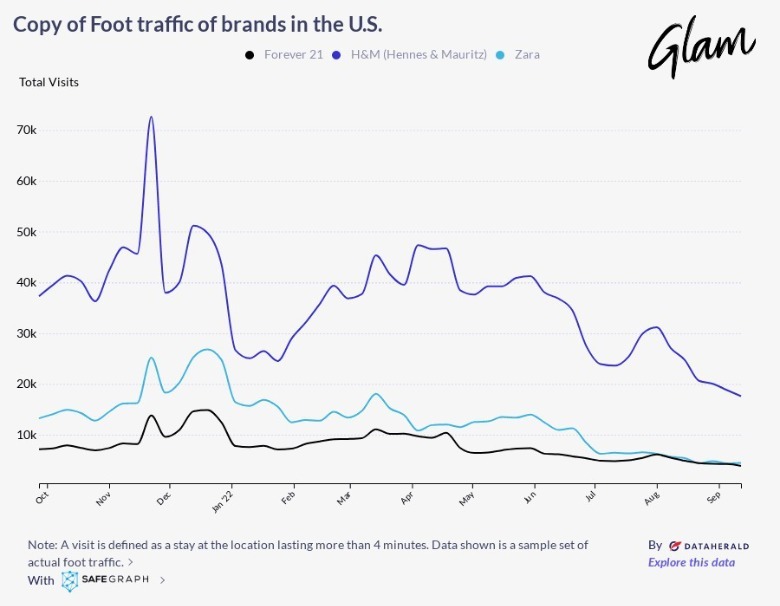Foot Traffic Struggles May Signal The End Of Fast Fashion Stores Dominating Shoppers' Closets
Today, fast fashion is everywhere you turn. Most fashion enthusiasts and environmental activists tell us fast fashion is bad, but there's no denying that its appeal to mainstream customers is enormous — and for all the right reasons. It's cheap. It's on the shelves fast. It offers you the next big look without you having to be seated in the first three rows at any fashion week show.
So, what exactly is fast fashion? Fast fashion garments are those that are replicated from the latest cat-walk trends and mass-produced at lower costs using lower-quality materials. The success of fast fashion, as consumer behavior expert Michael Solomon tells Vox, is that "it's about a disposable society." Per Solomon, the rise of fast fashion follows globalization and modern-day logistical efficiency. While fast fashion makes fashionable apparel more affordable to everyone, it has a slew of drawbacks.
Fast fashion also has a negative impact on the planet, with over 80% of all textiles going to waste every year. The use of cheap, dangerous chemical dyes in fast fashion makes the sector one of the world's worst sources of pollutants, Good On You warns. Despite its cult-like popularity, fast fashion is showing signs of a gradual downfall. Look at the foot traffic at Forever21, H&M, and Zara — the holy trinity of the global fast fashion industry — and you'll see where the industry is headed. And here's why we think fast fashion is on its way out.
Sustainability is the new trend
H&M appears to be the most well-liked fast fashion retailer in terms of foot traffic, per data collected by SafeGraph. H&M averaged 52,000 monthly visits from October to December 2021, followed by Zara with 19,600 and Forever21 with 10,600. During the holiday season, over 70,000 people visited H&M. From January to June 2022, H&M had an average monthly foot traffic of about 38,000 visits. Meanwhile, both Zara and Forever21 had a progressive slide, with average monthly visits of 13,500 and 9,000, respectively. In July, a historically slow month for retail since people are busy saving for the year-end holidays, all three companies hit their lowest marks. From August until October, however, all three retailers have continued seeing a steady decline in their in-store shoppers.
Although retail has its fast and slow months, we can't rule out the possibility that such a significant decline in foot traffic might have to do with a shift in shoppers' spending predilections. And the new trend that millennials and Gen Z are moving toward is sustainability and accountability, a 2021 Deloitte survey shows. In fact, young consumers are more eager to position themselves on critical issues regarding society, the environment, and politics. A 2000 McKinsey study also noticed a significant shift in consumers' sentiments towards sustainability post-pandemic lockdowns. More than 60% of customers polled said they don't mind going out of their way to recycle, while 57% reported significantly changing their lifestyles to reduce their environmental effects. Affordability and convenience remain the fundamental motivators in consumer purchasing decisions, but the desire to protect the environment is becoming a bigger factor.
Fast fashion brands might not keep up with consumers' demands
Going sustainable doesn't necessarily mean an adamant turn away from classic brands like H&M, Zara, or Forever21. That said, ethical fashion is becoming an inevitable trend, and fast fashion retailers must find a way to keep up. More than ever, an increasing number of individual shoppers and associations are keen to dig up the truth about the modus operandi of fast fashion and hold retailers' feet to the fire. Issues like lack of transparency in sourcing information, abuse of workers and underpayment, and release of hazardous waste, can put mass-market clothing brands in hot water. A 2019 McKinsey report confirmed this growing sentiment, stressing that sustainable sourcing is becoming a top priority for fashion companies.
Both H&M and Zara have publicized their environmental goals, which include the conservation of natural resources, banning hazardous chemicals in manufacturing, and launching collections that use eco-friendly materials. Following the death of a garment worker by her supervisor at its Indian supplier in 2021, H&M also reached a legally binding agreement earlier this year to eradicate sexual abuse and harassment against women, The Guardian reports. Zara also admitted in 2021 that it had underpaid its workers by an estimated $2.6 million and that it was working on compensating the affected employees. It's becoming increasingly obvious that unethical fashion is the formula for failure. However, it's not easy for sustainability and fast fashion to go hand in hand. Actually, the nature of fast fashion — the rapid manufacturing and shipping speeds as well as low buying costs — makes it quite challenging for fast fashion retailers to be completely sustainable and ethical.


